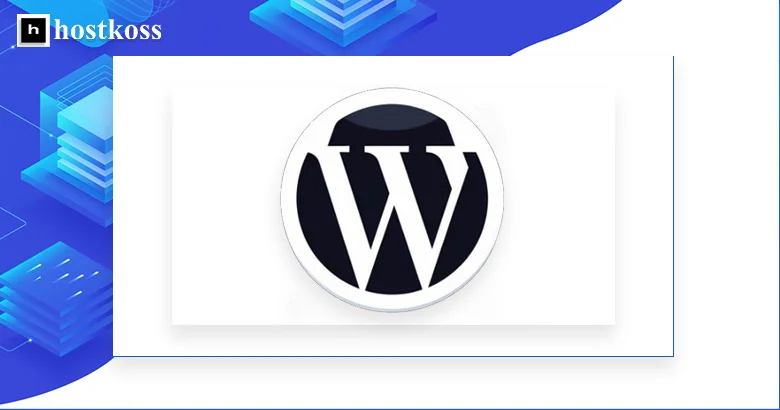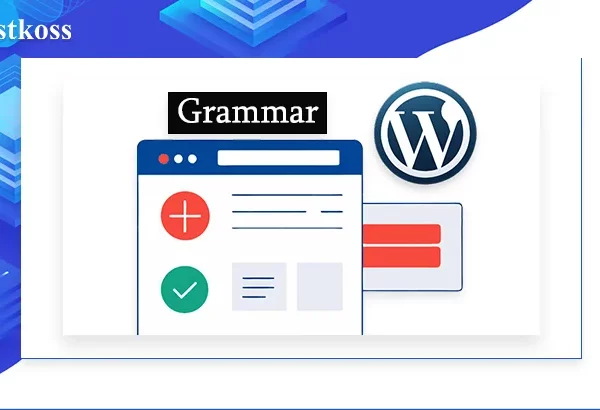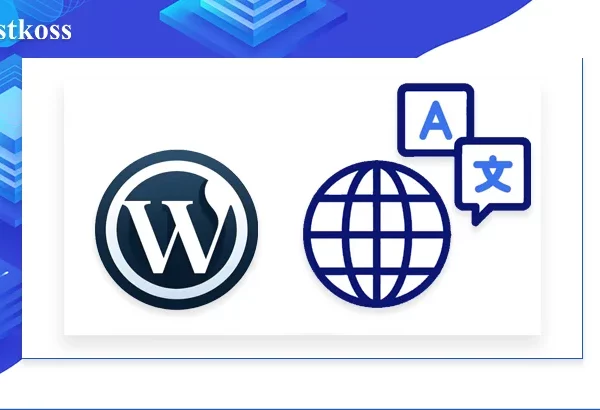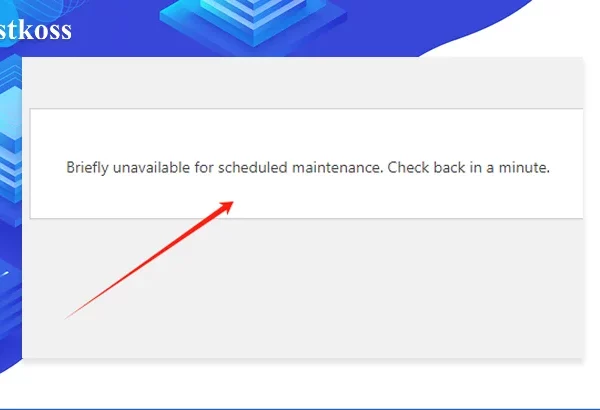WordPress is one of the most popular content management systems (CMS) in the world, and it’s no wonder. With its ease of use and powerful features, WordPress has become a favorite among website owners, bloggers, and developers. However, before you can take full advantage of WordPress, you need to learn how to log into the admin dashboard.
The WordPress dashboard, also known as the “admin area” or “backend”, is the central place where you can manage all aspects of your website. This is where you can create and edit pages and publications, install and customize plugins, change design themes, moderate comments, and much more.
In this article, we’ll take a detailed look at how to securely log into the WordPress admin area, regardless of your technical skill level.
- How to log in to your WordPress dashboard
- Change password in WordPress: detailed description
- Can’t log in to the WordPress dashboard: what to do?
- Two-factor authentication for WordPress
- Recommendations from Hostkoss
- Frequently Asked Questions and Answers
How to log in to your WordPress dashboard
To access all the powerful features of WordPress and fully manage your website, you need to log into your control panel. Here are step-by-step instructions on how to do this:
1. Open a web browser and type the following URL in the address bar: https://yourwebsite.com/wp-admin (replacing “yourwebsite.com” with your website’s actual domain).
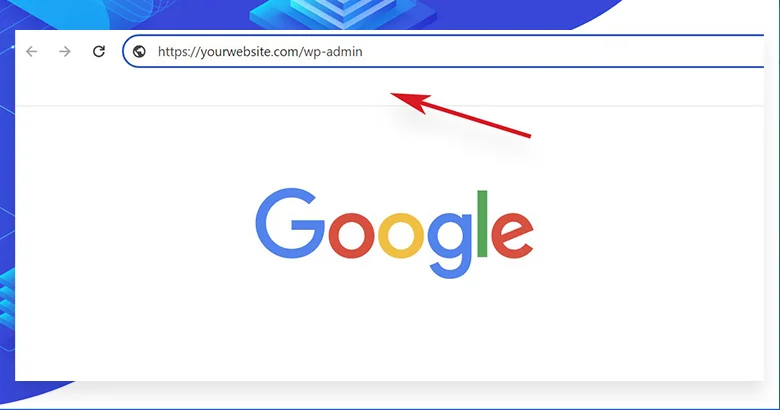
2. This URL will take you to the WordPress Control Panel login page. Here you will see fields to enter your user credentials.
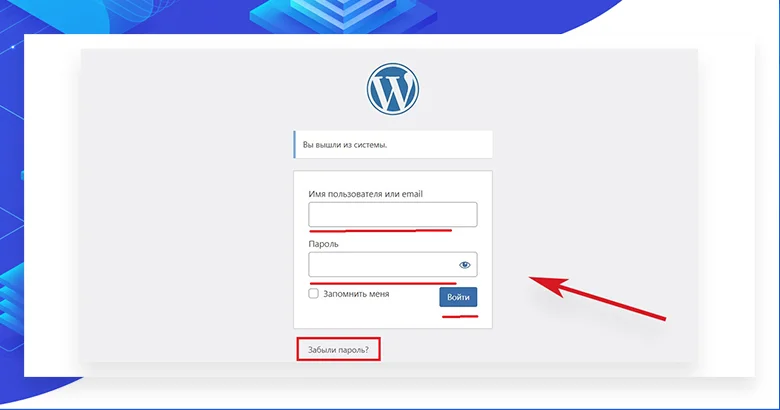
3. Enter your user login (usually your email) in the first “Username” field.
4. Then enter your password in the “Password” field. Note that passwords in WordPress are case sensitive, so enter it carefully.
5. Once you have entered your username and password, click the “Login” button.
6. If you have entered the correct credentials, you will be taken to the WordPress Control Panel where you can manage all aspects of your site.
If you have forgotten your password, click on the “Forgot Password?” link below the password field. This will allow you to reset your password using the email associated with your user account.
It’s important to remember that the WordPress Control Panel is the main place to administer your site, so ensure you have strong security by using a complex and unique password. It is also recommended that you change your password regularly to increase security.
Once you have successfully logged into wp-admin, you will be able to create and edit pages and publications, install and customize plugins, change the design theme, manage users, and customize all other aspects of your WordPress site.
Change password in WordPress: detailed description
Ensuring that your WordPress website has the proper level of security is a priority. One of the key security measures is to regularly change your admin password to a complex and unique password. Here’s a detailed description of the password change process in the WordPress Control Panel:
1. Log in to the WordPress Control Panel using your current username and password.
2. In the side menu, click on “Users” and then select “Your Profile“.
3. On the “Edit Profile” page, scroll down to the “Account” section.
4. Under the “Password” fields, find the “Change Password” link. Click on it.
5. In the “Change Password” window, enter your current password in the first field.
6. In the next two fields, enter your new desired password. Make sure the new password meets security guidelines:
- Minimum length of 12 characters
- Combination of upper and lower case letters
- Include numbers and special characters
- No dictionary words or personal information
7. After entering your new password, click the “Update Profile” button at the bottom of the page.
8. Exit the Control Panel by closing the tab or browser window.
9. Try logging in again using your username and new password. If you can successfully log in, it means that the password has been changed correctly.
Please note that once you change your password, your previous credentials will no longer work. Therefore, it is recommended that you only distribute the new password to authorized users who need access to the Control Panel.
For added security, it is recommended that you change your password regularly, at least every 3-6 months. It is also worth considering using a password manager to help you store and manage all your passwords securely.
Can’t log in to my WordPress dashboard: what to do?
Can’t log into the admin panel of your WordPress website? This can be a really stressful situation, but there’s no need to worry. There are several common reasons for login problems, and there are solutions for each of them. Let’s take a closer look at some of them.
Incorrect password. The most common cause is simply a forgotten or incorrectly entered password. Try checking your password thoroughly, paying attention to the case of the characters. If that doesn’t help, you can reset your password directly through the WordPress database or use the password reset feature in the admin panel.
Hosting issues. Sometimes, the reason why you can’t login to your WordPress dashboard can be due to a temporary glitch or maintenance on your hosting provider’s side. Contact your hosting provider to check if everything is working properly.
Blocking due to login attempts WordPress has a built-in security feature that temporarily locks accounts after a certain number of failed login attempts. This is done to protect against malicious attacks through password mining. In such a case, you just have to wait for a certain amount of time before trying again.
Plugin issues. Some WordPress plugins may conflict and cause problems with secure login. Try logging in in debug mode by disabling all plugins temporarily.
Problems with the .htaccess file. A corrupt or incorrect .htaccess file, which is responsible for access settings on your server, can block panel login. Check its contents or delete it temporarily to fix the problem. Managing WordPress with the .htaccess file
If the login problem persists after checking all these options, you can contact your hosting provider’s support team or WordPress customization professionals for help. It is important not to panic and thoroughly check all possible causes before taking drastic measures.
Two-Factor Authentication for WordPress
In a world where cybercrime is becoming more prevalent, ensuring the proper level of security for your WordPress site is essential. One effective way to increase the protection of your admin account is to implement two-factor authentication (2FA).
Two-factor authentication adds an extra layer of protection to the standard username and password combination. After entering your password, you will be required to confirm your identity with a second authentication factor, such as a one-time code generated by the authenticator app or sent to your cell phone.
Using 2FA to log into your WordPress Dashboard helps protect your site from attackers who can gain access to your credentials through phishing attacks, password theft, or spoofing. Even if hackers recognize your password, they won’t be able to log in without a second factor of authentication.
To implement two-factor authentication in WordPress, there are several popular plugins such as:
These plugins make it easy to set up an additional verification step using authenticator apps, SMS or backup codes. Most of them also offer the option to require 2FA for administrators only or for all site users.
While implementing two-factor authentication may seem like an extra step, the benefit of this solution is a significantly increased level of security for your WordPress site. This is why 2FA is recommended by leading security experts and is considered one of the best practices for protecting your online resources.
Don’t hesitate to strengthen the security of your WordPress site. Consider implementing two-factor authentication today and get the added peace of mind knowing that your site is protected from potential cyberattacks.
Recommendations from the Hostkoss team
If you’ve already tried every possible way to regain access to your WordPress Control Panel but the problem persists, don’t give up. The Hostkoss team has some additional tips and recommendations for you.
Check for viruses
One potential reason for losing access to the admin panel could be that your site has been infected with malware or viruses. Many attackers use viruses and malicious codes to lock out admins and gain control of a website. Therefore, we recommend thoroughly scanning your site for viruses with reliable antivirus tools.
Contact your hosting provider
If you have exhausted all possible options, don’t hesitate to contact your hosting provider for help with a ticket. Their experienced professionals can offer additional solutions or identify server-level issues that may have caused you to lose access to the Control Panel.
Read our other articles
We also recommend reading other useful articles on our blog that can help you better understand various aspects of WordPress and web development in general. Here are some sample articles that you may find useful:
- What is WordPress
- HTTP Status Codes: What They Mean
- What is a landing page and how to create one
- What is FTP? Advantages and disadvantages
- What is a .htaccess file: basic functions
- What is a web host? How it works
- How to create a WordPress site in 2024
These articles cover a variety of topics, from WordPress security to performance optimization, plugin configuration, and more. They will help you deepen your knowledge and better prepare you to deal with similar issues in the future.
Don’t give up and keep looking for a solution to regain access to your WordPress Dashboard. If all other options didn’t work, you can always contact WordPress experts or professional web developers for more help and advice.
Frequently Asked Questions and Answers
To access the control panel, you will need to enter the site/wp-admin URL into your browser and enter your admin credentials (username and password).
If you forget your password, you can reset it by submitting a password reset request in your login panel, or you can change it through your WordPress database using a database management program.
Access to the control panel is usually granted to administrators and authorized users with appropriate access rights. Regular site visitors do not have access to the admin panel.
Yes, it is recommended that you change your control panel password regularly for security reasons. This will help prevent unauthorized access and maintain control over your site.
In the control panel, you can customize almost every aspect of your website, including appearance, functionality, security, SEO tools, and more.
You can create new users and grant them the appropriate access rights in the Users section of your WordPress dashboard.
Yes, you can restrict access to the dashboard to only certain IP addresses by using security plugins or by configuring appropriate rules at the server or .htaccess level.
An error message when attempting to log in may indicate problems with permissions, hosting failures, database corruption, or hacking attempts.
If you have completely lost access to your control panel, you can try resetting your password through the database, checking the site for viruses, or contacting your hosting provider’s technical support for assistance.
